| Botanical Name |
|
| Family |
Scrophulariaceae - The snapdragon family. |
| Pronunciation |
|
| Common Name(s) |
English: Tree Fuchsia; Wild Fuschia; White Olive
Afrikaans: Notsung; Ouhout; Septee; Witolyf
IsiZulu: Indomela; Umbinza
|
| Plant Group |
- Tree A woody, self-supporting perennial plant usually with a single main stem and generally growing more than 6 meters tall.
|
| Plant Size |
- Very Small
| Tree | 3m to 4m |
| Shrub | 25cm to 50cm |
| Perennial/ground cover | Up to 10cm |
| Bulb | 10cm to 20cm |
| Succulent | Up to 5cm |
|
| Position |
- Canopy Shade Canopy shade is found below closely grown trees where some light filters through. Ideal for the protection of herbaceous plants.
- Dry Shade Shady areas where soil has poor water retention or are dependent on rain for their moisture needs.
- Light or Dappled Shade Found below trees with sparse, open foliage. Ideal for the protection of herbaceous plants.
- Partial Shade The area is in shade for part of the day and in full sun for part of the day.
- Sun The area is in full sun for all or most of the day, all year round.
|
| General Information |
- Attractive fruits, berries or seeds Brightly coloured fruits or berries increase and extend the visual impact of the plant and are especially attractive to birds and other small wildlife.
- Drought Tolerance: Moderate The plant is moderately adapted to arid conditions and can survive short periods of drought and high temperatures without extra water.
- Evergreen Plants that have leaves all year round.
- Frost: Half-hardy The plant is able to survive low temperatures and some frost but requires protection against severe frost.
- Water Moderate These plants will need some extra watering compared to water-wise plants. Plant them together, in at least some shade and in a convenient proximity to the house so that grey water can be utilised during times of drought.
- Wind Tolerant Plants able to withstand the effect of strong winds.
|
| Specific Information |
Halleria lucida forms a multi-stemmed shrub or small tree with attractive glossy green foliage on arching and drooping branches. The flowers, rich in nectar, are sometimes almost hidden amongst the foliage. This is an important shrub for attracting birds to the garden. Insect-, nectar- and fruit-eating birds all visit at various times and skulking birds will appreciate the protection and nesting places this dense shrub provides..
|
| Ad Break |
|
| Flowers |
| Description |
tubular, in clusters and singly, half-hidden among the leaves
|
| Season |
- Autumn to Spring Plants will seldom bloom for the entire season as given in the list, but should flower during a period within these parameters.
|
| Colour |
|
| Growth Rate |
- Fast Specifying growth rate can be very misleading as there is considerable variation of growth rate depending on type and species of plant, available water, supplementary feeding, mulching and general care, as well as the plants suitability and adaptability to the garden environment.
|
| Plant Uses |
- Attracts bees, butterflies or other insects This plant attracts insects which can be food for birds or other creatures in your garden.
- Attracts Birds This plant will attract birds.
- Border A strip of ground, at the edge of a driveway or path in which ornamental plants or shrubs are planted.
- Boundary A plant useful for planting around the edges of the property to form a green or colourful backdrop, an impenetrable hedge, to hide walls or create privacy.
- Container Trees, shrubs and ornamental species that can adapt to growing in a restricted environment.
- Filler Either a fast growing tree or shrub used temporarily to fill in an area while the permanent plants grow to a desired size, or a plant used to fill gaps in borders or beds.
- Hedge Suitable trees or shrubs planted relatively close together so that the branches intertwine to create a barrier. This can be formal – the plants are regularly trimmed to produce a neat shape, or informal – the plants are left to themselves to create a natural hedgerow.
- Pioneer for new gardens A very fast growing plant, able to withstand hardship, that can be used to populate land that has recently been cleared of natural vegetation. These plants pave the way for slower-growing species by adding nutrients to the soil and creating leaf litter.
- Provides light / dappled shade A tree with an open to sparse canopy, through which varying degrees of sunlight can penetrate.
- Suitable for coastal gardens Plants adapted to dry, sandy soil, forceful wind, limited rainfall and intense sunlight.
- Suitable for smaller gardens Such plants do not have invasive root systems, remain small or controllable and can often be grown in containers.
- Wild Garden An indigenous garden planted for the benefit of wildlife and birds. Provides food, water, a variety of mini-biomes and no poisonous chemicals are used.
|
| Distribution and Habitat |
from the Cape peninsula in the Western Cape, through the Eastern Cape, Lesotho, the eastern Free State, KwaZulu-Natal, Swaziland, Mpumalanga, Gauteng, the Northern and North West Provinces and in areas of Zimbabwe, in evergreen forest, forest margins, ravines, coastal bush, karroid scrub, on mountain slopes and near rivers and streams
|
| Planting Suggestions |
Plant in rich, well-drained loam with compost and mulch, and provide water all year round. Although it tolerates periods of drought, the tree fuchsia looks its best with a regular water supply. It is relatively frost hardy but should be protected from frost for the first 2 or 3 winters.
The old method of digging a deep hole and filling it with soil and compost has resulted in many trees failing to thrive, dying, rotting at the base or worse still, falling over in later years due to poor root development. Refer to the following sites for the best method of planting trees:
Treehelp.com: Planting a tree
International Society of Arboriculture: New Tree Planting
Tree People: Plant the right way
For those of you who have a clay problem try:
Rod's Garden: Planting in clay soil
|
| Medicinal Uses |
Medicinally, Halleria lucida has been used for skin and ear complaints. Dry leaves soaked in water and squeezed into the ear is said to relieve earache. The wood can be used to start a fire by friction. This tree is also considered to have magical properties against evil. Twigs are burnt when offering sacrifices to the ancestral spirits. To protect the residents from lightning and wizardry, these plants were set alight and the ashes combined with crocodile fat. This mixture was then spread onto branches of Rhamnus Prinoides (Dogwood), which were then erected the around the village.
|
| Ad Break |
|


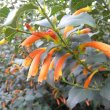
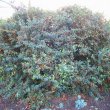
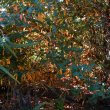
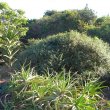
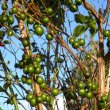
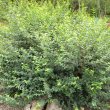

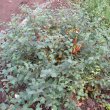
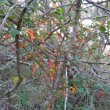


Comments
Tree Fushcia
Hi,
I planted 2 young tree fushcia's last year June/July, they were doing very nicely until about a month ago... both started losing their leaves. Their stems are green but the one is completely leafless and the other is about 70% leafless. Any ideas what the issue could be?
Cheers,
Dean
Tree fuschia in stress
Hi Dean
Unfortunately I cannot make a diagnosis based on so little information. I need to know where you are situated, what the type of soil, the frequency of water received by the plants, any unusual changes in climate, and if possible a clear image of the plant.
Kind regards
Lorraine
Halleria lucida losing leaves
I have the same problem except it's now January 2016. I'm in Midrand Gauteng. My 3 Tree Fuschias are against a north facing wall. I've only been watering bare minimum because of the drought. If I hadn't read they were evergreen, I would've thought they had autumn foliage on. The 3 are on a very slight gradient- the one at the only slightly highest point started turning yellow first so I upped its water intake. The other two were fine but are now looking decidedly autumn-y. There is a 2m high very healthy Lavender Tree (sapling) neat the Tree Fuschias and 2 Hypoestes in the same bed at the "higher end", which appear to be growing 1/2m a day! We call them The Triffids! I will attempt to send photo from my pc later. Many thanks Lorraine. I really enjoy the info imparted on your site.
Halleria Lucida
Looking at Dean's letter to you I had the same problem, I have come to the conclusion that the tree fuchsia likes some shade as I had one in JHB which had partial day shade and thrived. In Durban last year May I purchased it from the Botanical Gardens Fair, it grew beautifully but lost all its leaves during the very hot months, I watered it nightly (the branches) as the sun went down and new leaves formed and it is happy; I only hope that it will adjust itself by next summer as it will be in the sun all day then.
Discuss this plant
Share knowledge, ask a question or give an experience.